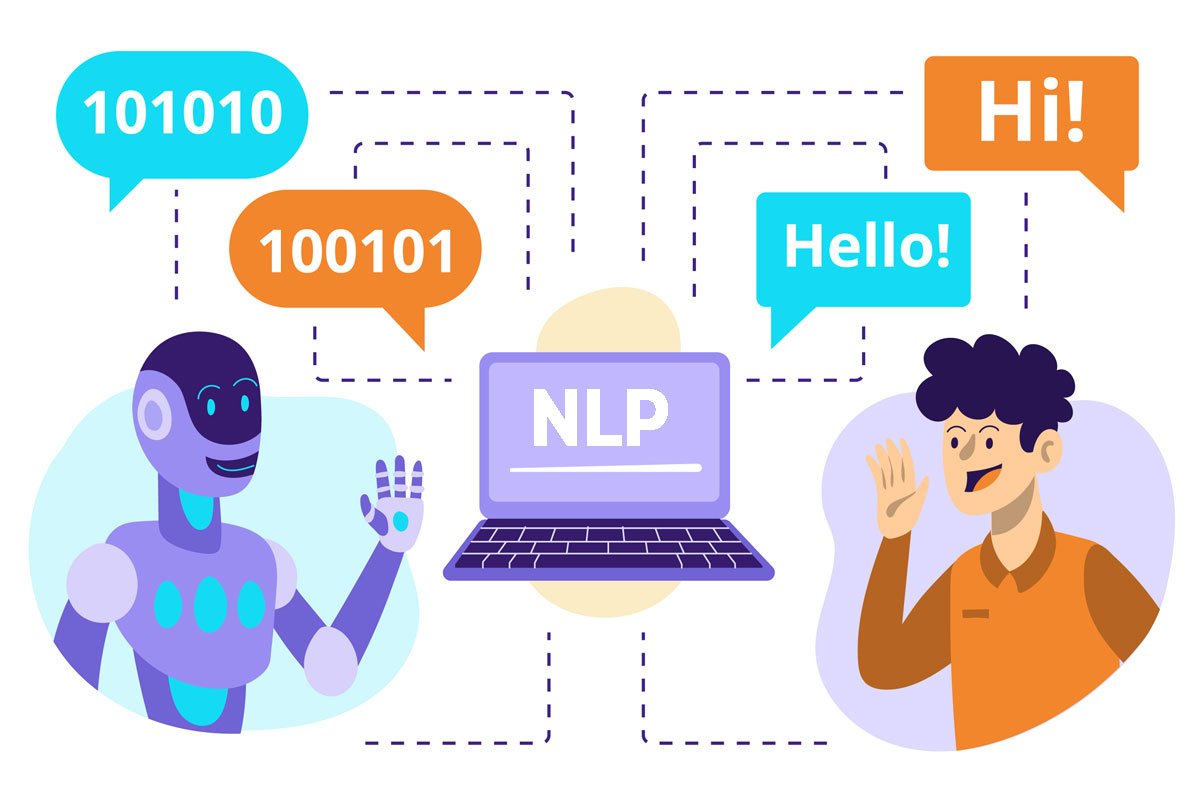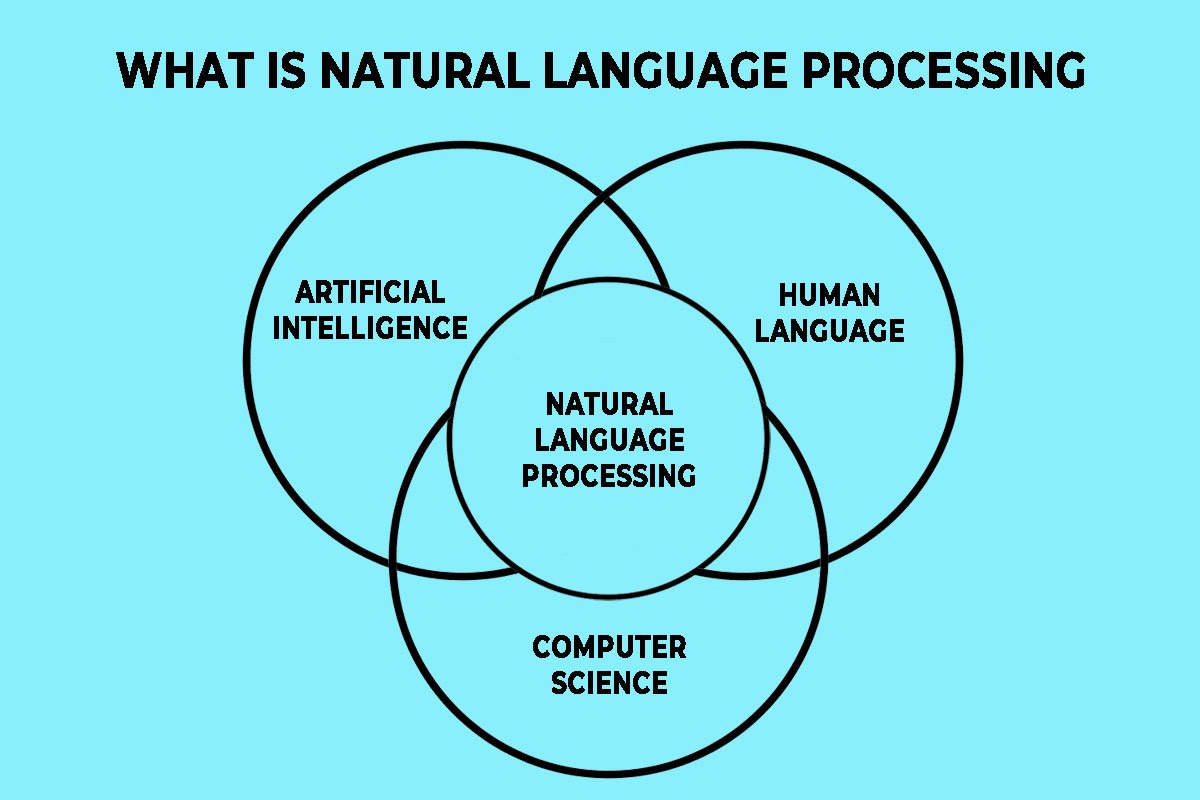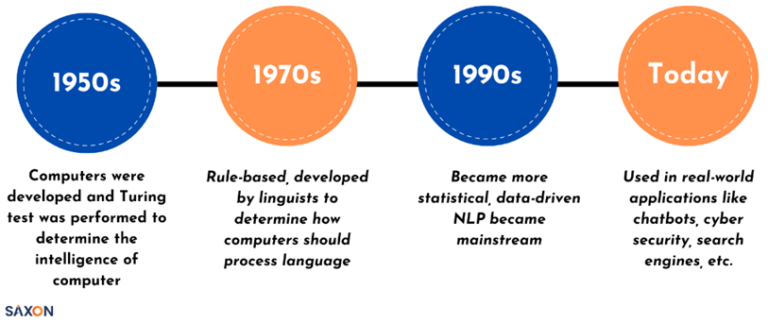NLP (Natural language processing), you might have heard about this topic recently after ChatGPT. So you might be wondering What is Natural language processing, when was it created, and what are its use cases, examples tools and challenges? In this article, we will understand what is Natural Language Processing.
History of NLP
The story dates back to 1950 when computer scientist Alan Turing came up with a test that NLP could use to determine if the machine was capable of demonstrating human-like intelligence.
In the 1960s, early NLP systems were developed to translate text between different languages, but these systems were often rule-based and required extensive manual coding.
Statistical methods were started to be applied for NLP in the 1980s and 1990s with a view to getting more precise and effective processing of linguistic data. NLP has been transformed since the beginning of 2000 when AI and deep learning algorithms began to be developed which allowed us to develop more advanced models for applications such as sentiment analysis, machine translation or chatbot development.
Today, NLP is a highly innovative and fast-growing area with numerous exciting uses in fields such as health care, finance or e-commerce. In the years ahead, as technology improves even further, there is likely to be an increasing number of innovative and technically advanced NLP applications.
What is Natural Language processing?

Natural language processing NLP is a subfield in artificial intelligence that focuses on computers’ ability to understand, interpret and generate human languages. NLP is a way of teaching machines to understand natural language by using computational and mathematical techniques to analyze and model language data. NLP aims at enabling machines to process and interpret the language of people in a way similar to how humans do it.
f Natural language processing involves the use of various techniques and algorithms to break down natural language data into smaller, more manageable components. These components can then be analyzed and modelled to derive meaning and context from the language.
Examples of Natural language processing
One common example of NLP is the use of chatbots. Chatbots are computer programs that simulate human conversation using NLP techniques. They can help customers find information or answer questions on websites, social media platforms, or messaging apps.
A chatbot uses NLP to analyze the user’s input and understand the intent behind it. It then uses this understanding to provide an appropriate response. For example: when users want a chatbot that can help them know about the weather, it will be able to analyse their input and answer their questions in an intelligent way by using linguistic processing techniques.
Use cases of Natural language processing
NLP has many applications across different industries. Here are a few examples:
Sentiment analysis
Sentiment analysis is the process of using NLP to analyze social media posts, customer reviews, or surveys to understand the sentiment (positive, negative, or neutral) behind them. In order to collect feedback on customers, detect possible issues and improve customer satisfaction, businesses can take advantage of sentiment analysis.
Language Translation
NLP can be used to translate text or speech from one language to another. Translation software uses NLP techniques to analyze and understand the meaning of the input text or speech and then generate a corresponding translation in the target language.
Speech recognition
NLP can be used to transcribe spoken words into text. Speech recognition software uses NLP techniques to analyze and understand spoken language and convert it into written text.
Text summarization
NLP can be used to automatically summarize long pieces of text, such as news articles or research papers. Text summarization software uses NLP techniques to identify the key points and ideas in the text and create a concise summary.
NLP tools
There are many NLP tools available, ranging from open-source libraries to commercial software. Here is the list of a few popular tools
NLTK (Natural Language Toolkit):
NLTK is a popular open-source library for NLP that provides tools and resources for natural language processing tasks such as tokenization, stemming, and sentiment analysis.
spaCy
spaCy is another popular open-source library for NLP that provides tools for natural language processing tasks such as named entity recognition, part-of-speech tagging, and dependency parsing.
Gensim:
Gensim is an open-source library for NLP that provides tools for topic modelling, text similarity analysis, and document indexing.
Stanford CoreNLP
Stanford CoreNLP is a suite of tools for natural language processing developed by Stanford University. It provides tools for tasks such as part-of-speech tagging, named entity recognition, sentiment analysis, and dependency parsing.
Google Cloud Natural Language API
Google Cloud Natural Language API is a cloud-based NLP service that provides tools for tasks such as sentiment analysis, entity recognition, and syntax analysis.
Amazon Comprehend
Amazon Comprehend is a cloud-based NLP service that provides tools for tasks such as sentiment analysis, entity recognition, and topic modelling.
Key challenges of Natural language processing:
Ambiguity and Complexity of Language
The complexity of the human language is one of the biggest challenges for NLP. Natural language is full of nuances, idioms, sarcasm, and context-dependent meanings that can make it difficult for machines to interpret accurately.
Lack of Standardization
We do not have a standard human language, it varies widely in regions, cultures and individuals. This makes it challenging for NLP models to generalize across different types of language data.
Lack of High-Quality Language Data
In order to train NLP models effectively, it is important to have large amounts of high-quality data that is representative of the language being modelled. However, obtaining and labelling high-quality language data can be expensive and time-consuming.
Domain-Specific Language
The language used in specialized domains such as legal, medical or technical fields can be complex and challenging for NLP models to interpret.
Machine Learning Challenges
NLP models often require large amounts of computing resources to train effectively. This is particularly challenging for a small organization with limited resources.
Privacy Concerns
NLP models may deal with sensitive information such as personal health data, financial information, or confidential business data. This raises concerns about data privacy and security.
Ethics
NLP models can have unintended consequences if not carefully designed and monitored. For example, biased language models can perpetuate social inequalities or cause harm to vulnerable populations.
Despite the challenges, we have seen considerable progress in Natural language processing in the past few years, with rapid development in technology and increased use of NLP in various sectors. We would see more sophisticated applications in near future.
Conclusion
In summary, NLP is a subfield of AI that enables machines to understand, interpret, and generate human language. In addition, it can be used to perform functions such as sentiment analysis, language translations, speech recognition and the summarization of texts across industries.
It’s been growing in importance over the last few years as a result of increasing numbers of online content, like Social Media posts, customer reviews, NeuroLinguistic Programming and other user-generated content. Businesses can use NLP to gain insights into customer sentiment, identify trends, and improve customer satisfaction.
I have mentioned limited Examples, tools, and use cases of Natural language processing. When you get into deep learning about NLP you will discover more challenges, examples and tools.



